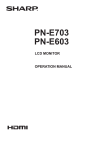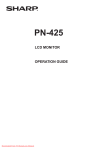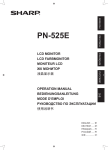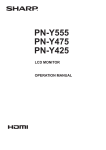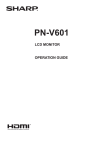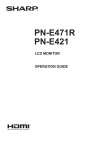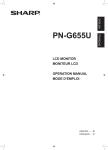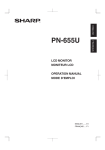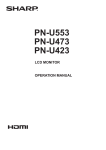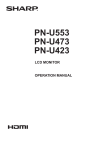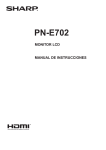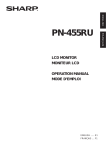Download Sharp PN-S655 user manual Tv User Guide Manual Operating
Transcript
PN-S655 LCD MONITOR OPERATION GUIDE Downloaded From TV-Manual.com Manuals Contents Basic Operation................................................................3 Menu Items........................................................................5 Displaying the menu screen..........................................5 Menu item details..........................................................6 Adjustments for PC screen display.............................10 Initialization (Reset)/Functional Restriction Setting.... 11 Controlling the Monitor with a PC (RS-232C)...............12 PC connection.............................................................12 Communication conditions..........................................12 Communication procedure..........................................12 RS-232C command table............................................16 Controlling the Monitor with a PC (LAN)......................21 Settings to connect to a LAN.......................................21 Controlling with a PC...................................................23 This guide contains instructions regarding operation, settings, and similar details. For instructions regarding connection and installation, refer to the included Operation Manual. Manual Scope - Microsoft, Windows and Internet Explorer are registered trademarks of Microsoft Corporation. - HDMI, the HDMI Logo and High-Definition Multimedia Interface are trademarks or registered trademarks of HDMI Licensing LLC. - Adobe, Acrobat, and Reader are either registered trademarks or trademarks of Adobe Systems Incorporated in the United States and/or other countries. - This product comes with RICOH Bitmap Fonts produced and sold by RICOH COMPANY, LTD. - All other brand and product names are trademarks or registered trademarks of their respective holders. - Language of OSD menu used in this manual is English by way of example. - Illustrations in this manual may not exactly represent the actual product or display. 2 E Downloaded From TV-Manual.com Manuals Basic Operation 5. BRIGHT +/- (Backlight adjustment) or displays the BRIGHT menu when the Pressing menu screen is not displayed. 1 2 BRIGHT 3 4 15 Press or to adjust the brightness. * If you do not press any buttons for about 4 seconds, the BRIGHT menu automatically disappears. 5 6. SIZE (Screen size selection) The menu is displayed. Press or to select the screen size. (See page 4.) 6 7 7. DISPLAY Displays monitor information. Every time you press this button, the display changes from INFORMATION 1 → INFORMATION 2 → display clear and so on. 8 INFORMATION 1 1. INPUT (Input mode selection) or to select the input The menu is displayed. Press mode, and press to enter. * You can select the input terminal by pressing the input switch of the monitor. Input mode Video PC1 DVI-D*1 PC1 input terminal PC2 HDMI*2 PC2 input terminal PC3 D-SUB PC3 input terminal PC4 RGB*3 PC4 input terminals AV1 DVI-D*1 AV1 input terminal AV2 HDMI*2 AV2 input terminal AV3 COMPONENT*3 AV3 input terminals AV4 S-VIDEO AV4 input terminal AV5 VIDEO AV5 input terminal Audio PC audio input terminal AV audio input terminals *1 Select the terminal for DVI SELECT. (See page 7.) *2 Select the terminal for HDMI SELECT. (See page 7.) Select the terminal for HDMI AUDIO SELECT which is used for audio input. (See page 7.) *3 Select the terminal for BNC SELECT. (See page 7.) 2. MUTE Turns off the volume temporarily. Press the MUTE button again to turn the sound back to the previous level. 3. MENU Displays and turns off the menu screen (see page 5). 4. VOL +/- (Volume adjustment) Pressing or displays the VOLUME menu when the menu screen is not displayed. VOLUME 15 XXXX/XX/XX XXX INPUT MODE : PC3 D-SUB SIZE : WIDE COLOR MODE : STD BRIGHT : 15 VOLUME : 15 ID No. : 0 MODEL : PN-S655 S/N : STATUS : LAN 1920x1080 V: 60 Hz INFORMATION 2 XX:XX:XX XXXX-XXXX-XXXX-XXXX H: 66.3 kHz XXXX/XX/XX XXX XX:XX:XX RS-232C/LAN SELECT : LAN DHCP CLIENT : OFF IP ADDRESS : XXX.XXX.XXX.XXX SUBNET MASK : XXX.XXX.XXX.XXX DEFAULT GATEWAY : XXX.XXX.XXX.XXX MONITOR NAME : XXXXXXXXXXXX DATA PORT : XXXXX MAC ADDRESS : XX-XX-XX-XX-XX-XX LAN 1920x1080 V: 60 Hz H: 66.3 kHz • The display disappears automatically after about 15 seconds. • LAN is displayed during LAN communication. 8. MODE (Color mode selection) Each time you press this button, the color mode changes in the following order: STD (Standard) → VIVID → sRGB → STD... • sRGB applies to PC input only. sRGB is international standard of color representation specified by IEC (International Electrotechnical Commission). Color conversion is made in taking account of liquid crystal’s characteristics and represents color tone close to its original image. Press or to adjust the volume of the sound. * If you do not press any buttons for about 4 seconds, the VOLUME menu automatically disappears. Downloaded From TV-Manual.com Manuals 3 E Basic Operation nSwitching the screen size Even when the screen size is changed, the display may remain the same depending on the input signal. WIDE ZOOM 1 PC input Displays image so it fills the entire screen. AV input An image with a 4:3 aspect ratio is stretched to fill the entire screen. PC input An image with a 4:3 aspect ratio is enlarged to fill the entire screen without changing the aspect ratio. The edges of the image may be cut off. AV input ZOOM 2 PC input Use this size if ZOOM 1 cuts off the subtitles. AV input NORMAL Dot by Dot PC input Displays image so it fills the screen without changing the aspect ratio of the input signals. AV input Displays the entire image of the aspect ratio of 4:3 without changing the aspect ratio. PC input Displays the dots of the signals input from the connected PC as the corresponding dots on the screen. * AV input Displays the dots of the input signals as the corresponding dots on the screen. *: With a monitor of screen resolution 1600 x 1200 or 1920 x 1200, selecting Dot by Dot displays the NORMAL screen. TIPS • Using this monitor’s screen-size switching or dual-screen display functions to compress or expand the screen for commercial or public viewing in establishments like cafes or hotels may infringe on the rights of the creators, as protected by Copyright Law, so please be careful. • When “Enlarge” is set, the screen size is fixed to “WIDE” mode. • When dual-screen display is selected, the screen size cannot be changed. • The appearance of the original video may change if you select a screen size with a different aspect ratio than the original image (e.g. TV broadcast or video input from external equipment). • When an ordinary non-wide image (4:3) is viewed with the whole screen using the screen-size switching function of this monitor, the edge of the image may be lost or appear distorted. If you wish to respect the creator’s intentions, set the screen size to “NORMAL”. • When playing commercial software, parts of the image (like subtitles) may be cropped. In this case select the optimal screen size using the screen-size switching function of this monitor. With some software, there may be noise or distortion at the edges of the screen. This is due to the characteristics of the software, and is not a malfunction. • Depending on the original image size, black bands may remain at the edges of the screen. 4 E Downloaded From TV-Manual.com Manuals Menu Items Displaying the menu screen nMenu screen display Video and audio adjustment and settings of various functions are enabled. This section describes how to use the menu items. See pages 6 to 8 for details of each menu items. nExample of operation (Adjusting CONTRAST in the PICTURE menu) 1. Press MENU SCREEN to display the menu screen. SCREEN 1/1 AUTO CLOCK PHASE H-POS V-POS H-SIZE V-SIZE H-RESOLUTION V-RESOLUTION RESET PICTURE AUDIO SETUP OPTION ENLARGE PIP/PbyP 1920x1080 PC3 D-SUB 600 31 150 31 50 50 1920 1080 V: 60 Hz or SCREEN H: 66.3 kHz END···[MENU] PICTURE 2 1/2 4 PC3 D-SUB AUTO AUDIO CONTRAST 30 SETUP BLACK LEVEL 96 OPTION TINT 30 ENLARGE COLORS 30 PIP/PbyP SHARPNESS 12 V: 60 Hz H: 66.3 kHz OK···[MENU] 1 Name of the menu 2 Input mode 3 An item being selected (highlighted) 4 Screen resolution of input signal, and other data. TIPS . • Items that cannot be selected appear in gray. (e.g. Function not supported by the current input signal) 1/2 PC3 D-SUB AUTO AUDIO CONTRAST 30 SETUP BLACK LEVEL 96 OPTION TINT 30 ENLARGE COLORS 30 PIP/PbyP SHARPNESS 12 1920x1080 4. Press or V: 60 Hz OK···[MENU] H: 66.3 kHz to adjust the setting. PICTURE PC3 D-SUB 1/2 AUTO PICTURE AUDIO CONTRAST 40 SETUP BLACK LEVEL 96 OPTION TINT 30 ENLARGE COLORS 30 PIP/PbyP SHARPNESS 12 1920x1080 For items that have MENU press . 5. Press 3 to select CONTRAST. PICTURE PICTURE SCREEN PICTURE 1920x1080 or to select PICTURE, and press 2. Press PICTURE menu is displayed. 3. Press 1 SCREEN MENU V: 60 Hz H: 66.3 kHz , press OK···[MENU] , make settings and then twice to close the menu screen. TIPS • The menu will differ depending on the input mode. • The menu screen will close automatically if no operation is performed for about 15 seconds. (DATE/TIME SETTING, SCHEDULE and LAN SETUP screens will close in about 4 minutes.) Downloaded From TV-Manual.com Manuals 5 E Menu Items Menu item details The menu will differ depending on the input mode. nSCREEN AUTO (PC3/PC4) The CLOCK, PHASE, H-POS, and V-POS are automatically adjusted. Pressing performs adjustment. Use this automatic adjustment when you use the PC3 input terminal or PC4 input terminals to display a PC screen for the first time or when you change the setting of the PC. (See page 10.) CLOCK (PC3/PC4) Adjusts frequency for sampling clock for applicable video. Adjust when there is flickering in the form of vertical stripes. When using the adjustment pattern (see page 10), make adjustments so that no vertical stripe noise appears in it. PHASE (PC3/PC4) Adjusts sampling clock phase for applicable video. Useful when small characters appear with low contrast and/ or there are flickers at corners. When using the adjustment pattern (see page 10), make adjustments so that no horizontal stripe noise appears in it. * Adjustments to PHASE should be made only after CLOCK has been correctly set. H-POS Adjust the horizontal position of the image. V-POS Adjust the vertical position of the image. H-SIZE Adjust the horizontal size of the image. V-SIZE Adjust the vertical size of the image. H-RESOLUTION (PC3/PC4) Sets proper horizontal resolution when the resolution of input signals is not recognized properly. (Adjustment may be impossible with some signals.) V-RESOLUTION (PC3/PC4) Sets proper vertical resolution when the resolution of input signals is not recognized properly. (Adjustment may be impossible with some signals.) RESET Resets the values of the SCREEN menu items to the factory preset values. MENU Select “ON” and then press . nPICTURE AUTO (PC3/PC4) The CONTRAST and BLACK LEVEL are automatically adjusted. Pressing performs adjustment. CONTRAST Adjusts the brightness of the image. BLACK LEVEL Adjusts the entire brightness of the video signals. TINT Adjusts the hue. Selecting + changes the color towards green, and selecting - changes it towards magenta. 6 E Downloaded From TV-Manual.com Manuals COLORS Adjusts the color intensity. SHARPNESS Adjusts the sharpness of the image. ADVANCED (AV input) You can adjust more specifically. (See page 10.) COLOR MODE Changes the color mode on the screen. The color mode on the screen can also be changed using a remote control unit. (See page 3.) * sRGB is PC input only. See page 3 for details. WHITE BALANCE THRU............... Displays the input signal level as is. (for PC1/ PC2 only) PRESET.......... Selects the color temperature using PRESET. USER............... Used for adjusting R-CONTRAST, G-CONTRAST, and B-CONTRAST respectively. PRESET Selects the color temperature when the WHITE BALANCE is set to PRESET. The setting values are shown for reference. The color temperature of the screen varies over time. This function is not intended to keep the color temperature constant. R-CONTRAST Adjusts red component when the WHITE BALANCE is set to USER. G-CONTRAST Adjusts green component when the WHITE BALANCE is set to USER. B-CONTRAST Adjusts blue component when the WHITE BALANCE is set to USER. COPY TO USER Copies the value set for PRESET to the USER setting. MENU . Select “ON” and then press GAMMA Select a gamma value. RESET Resets the values of the PICTURE menu items to the factory preset values. MENU . Select “ON” and then press nAUDIO TREBLE Adjusts the volume of treble-level sound. BASS Adjusts the volume of bass-level sound. BALANCE Adjusts the balance of the audio sound between right and left. RESET Resets the values of the AUDIO menu items to the factory preset values. MENU Select “ON” and then press . Menu Items nSETUP nOPTION OSD H-POSITION Adjusts the horizontal display position of menu screen. OSD V-POSITION Adjusts the vertical display position of menu screen. LANGUAGE Sets the display language for the menu screen. HDMI AUTO VIEW When ON is selected, the screen size is adjusted automatically according to the screen size control signal included in the video signal input from the AV2 input terminal. PICTURE FLIP A picture flips to appear. MIRROR ABC UPSIDE DOWN CBA ROTATE ABC ABC STANDARD POWER ON DELAY You can delay the screen display after the monitor is turned on. The period can be set up to 60 seconds in units of one second. When this function is activated, the power LED flashes (at approx. 1 second interval) in orange. This function is disabled when 0 is specified. STANDBY MODE When STANDARD is selected, startup time from standby mode is reduced. Note, however that, more power will be consumed in standby mode. When LOW POWER is selected, current consumption is reduced while the monitor is in standby mode. Note, however, that the startup time from standby mode becomes longer. Also, certain RS-232C commands cannot be used in standby mode. (See page 16.) RS-232C/LAN SELECT Selects the method with which to control the monitor from the computer. RS-232C/LAN COMMAND Set the return value for the RS-232C command. Normally, you do not need to change this setting from NORMAL. NORMAL....... The end code of the return value is CR+LF. MODE1.......... The end code of the return value is CR only. MODE2.......... The length of the return value is fixed to 4 digits. The end code is CR only. When the return value has 1 to 3 digits, the empty digit(s) from the left is filled with a one-byte space(s). ID No. SET Assigns ID numbers to monitors connected in a daisy chain (see page 13), using RS-232 cables. The numbers 1 to 255 are available for ID numbers. If “0” is set, the system regards this as the state where no ID number is set. LAN SETUP Configures the settings to control the monitor from the computer via LAN. (See page 21.) Downloaded From TV-Manual.com Manuals DATE/TIME SETTING to select the date or Set the date and time. Press and time, and press or to change the numerical values. Set the date in “Year/Month/Day” order. Set the time on a 24-hour basis. SCHEDULE (See page 9.) You can set the time to switch the monitor on and off. INPUT SELECT DVI SELECT........Selects the input mode to be used. BNC SELECT......Selects the input mode to be used. HDMI SELECT....Selects the input mode to be used. HDMI AUDIO SELECT...Selects a terminal to which audio signals are input in PC2/AV2 mode. QUICK SHOOT Reduces the visual lag inherent in fast-motion scenes. AUDIO OUTPUT Sets the volume of sound output from the PC/AV audio output terminals. VARIABLE...........You can adjust the volume using VOLUME. FIXED..................Fixes the sounds. INPUT SIGNAL (PC3/PC4) If a computer connected to the PC3/PC4 input terminal outputs any of the following resolutions, make a selection from the following options. 480 LINES...........AUTO, 640x480 or 848x480 768 LINES...........AUTO, 1024x768, 1280x768, or 1360x768 1050 LINES.........1400x1050 or 1680x1050 SCAN MODE (AV input) Sets the scan mode used for AV mode input. MODE1................Over-scan display MODE2................Under-scan display MODE3................Under-scan display when the input signal is 1080i/p. Otherwise, over-scan display * Even when MODE1 is selected, under-scan display is used when the input signal is 1080i/p and the screen size is Dot by Dot. SELF ADJUST On a PC3/PC4 screen, specify whether to perform screen adjustment automatically or not. When ON is selected, the screen is automatically adjusted when its resolution is 800 x 600 or higher and the timing of input signals changes. “ADJUSTING” appears on the screen during the adjustment. POWER MANAGEMENT POWER MANAGEMENT determines whether or not to switch modes from no signal to the input signal standby mode when the PC screen is displayed. AUTO INPUT CHANGE Specify whether to change inputs automatically. When ON is selected and no signal is present in the selected input mode, AUTO INPUT CHANGE automatically changes the selected mode to another mode where a video signal is present. When video signals exist in multiple input modes, the switching priority is as follows: PC1, PC2, PC3, PC4, AV1, AV2, AV3, AV4 and AV5. (Input mode switching may take 15 seconds or more, depending on the connected equipment. Input signals may not be detected properly and a priority may change, depending on the connected equipment or video signals.) 7 E Menu Items COLOR SYSTEM Select the color system of the AV equipment which is connected to AV4 and AV5 input terminal. (AUTO / PAL / PAL-60 / SECAM / NTSC3.58 / NTSC4.43) When AUTO is selected, the color system is automatically set according to the input signal. nENLARGE (PC input) ENLARGE H Sets the number of screen splits (number of monitors) in the longest direction used for the enlargement. (See page 9.) ENLARGE V Sets the number of screen splits (number of monitors) in the shortest direction used for the enlargement. (See page 9.) ENLARGE-POS H / ENLARGE-POS V Specify the split screen to be displayed when the enlargement function is used. (See page 9.) BEZEL H / BEZEL V Sets the frame width of the display when the enlargement function is used. H-POS Adjust the horizontal position of the enlarged screen. V-POS Adjust the vertical position of the enlarged screen. AUTO OFF Sets the display method when no signals for the sub screen are input in PIP, PbyP, or PbyP2 mode. MANUAL........ Displays a main screen and a black sub screen. AUTO............. Displays the main screen as a full screen. TIPS • When WHITE BALANCE is set to THRU, BLACK LEVEL, CONTRAST, TINT, COLORS and GAMMA cannot be set. • If COLOR MODE is set to sRGB or VIVID, the following items cannot be set. WHITE BALANCE, PRESET, R-/G-/B-CONTRAST, COPY TO USER, and GAMMA nDual screen display You can display the screens of the PC input signal and AV input signal simultaneously. Set this function with “PIP MODES” in the PIP/PbyP menu. PIP Sub screen PbyP Main screen nPIP/PbyP PIP MODES Sets the display method. OFF..........Displays one screen. PIP............Displays a sub screen inside a main screen. PbyP.........Displays a main screen and a sub screen in a line. PbyP2.......Displays a main screen which measures 1280 pixels in the longest direction and a sub screen in a line. PIP SIZE Sets the size of the sub screen in PIP mode. PIP H-POS Adjusts the horizontal position of the sub screen in PIP mode. PIP V-POS Adjusts the vertical position of the sub screen in PIP mode. PIP BLEND In PIP mode, use this menu item to display the sub screen transparently. PIP SOURCE Selects the input signal of the sub screen in PIP, PbyP, or PbyP2 mode. SOUND CHANGE Sets the sound which is output in PIP, PbyP, or PbyP2 mode. If the main screen is displayed as a full screen by the AUTO OFF function, the sound for the main screen is output even when the sound for the sub screen is specified. MAIN POS Sets the position of the main screen in PbyP or PbyP2 mode. PbyP2 POS Sets the position of the sub screen in PbyP2 mode. 8 E Downloaded From TV-Manual.com Manuals A sub screen is displayed inside a main screen. Main screen Sub screen PbyP2 Main screen Sub screen A main screen and a sub screen are displayed in a line. Displays a main screen which measures 1280 pixels in the longest direction and a sub screen in a line. * The currently selected input signal is displayed on the main screen. * You cannot simultaneously display the screens of signals of the same type, such as two types of PC input signals or two types of AV input signals. * The dual screen display cannot be used with the combination of PC1 and AV2 or of AV1 and PC2. TIPS • You might infringe on a copyright of the author which is protected by copyright law when you display the images of the computer screen and television/VCR simultaneously for profit-making or to show the image to the public. • The screen size for dual-screen display is the same as the screen size for single-screen display. The Dot by Dot screen is displayed in NORMAL size except when it is set as the PIP main screen. • When dual-screen display is selected, the AUTO INPUT CHANGE function is disabled. • When dual-screen display is selected, the screen cannot be enlarged. • When dual-screen display is selected, the following adjustments of ADVANCED are invalid and adjusting is disabled. 3D-NR, MPEG-NR and 3D-Y/C • When dual-screen display is selected, the INPUT SELECT options cannot be set. Menu Items nEnlarge nSCHEDULE • You can align several monitors and integrate them into a single large screen to display. • Up to five monitors can be aligned in both the longest and shortest directions. • Each monitor displays enlarged views of separated images. (Example) Longest direction: 2 monitors Shortest direction: 2 monitors You can set the time to switch the monitor on and off. Set this function with “SCHEDULE” in the OPTION menu. (See page 7.) Longest direction: 3 monitors Shortest direction: 2 monitors PC3 D-SUB SCHEDULE XXXX/XX/XX XXX XX:XX:XX No. (1) POWER (2) 1920x1080 DAY OF THE WEEK (3) V: 60 Hz TIME (4) H: 66.3 kHz INPUT (5) OK…[MENU] 1. Press or to select the SCHEDULE number, and press . 2. Set the SCHEDULE. (See the description below.) Setting procedure In the ENLARGE menu, set ENLARGE H/V and ENLARGE-POS H/V. (See page 8.) 1. Set the number of monitors aligned in the longest direction in ENLARGE H. 2. Set the number of monitors aligned in the shortest direction in ENLARGE V. 3. Set the section of the separated image to be displayed on each monitor in ENLARGE-POS H and ENLARGE-POS V. ENLARGE H ENLARGE V 1 2 3 4 5 1 (1,1) (2,1) (3,1) (4,1) (5,1) 2 (1,2) (2,2) (3,2) (4,2) (5,2) 3 (1,3) (2,3) (3,3) (4,3) (5,3) 4 (1,4) (2,4) (3,4) (4,4) (5,4) 5 (1,5) (2,5) (3,5) (4,5) (5,5) * The numbers in parentheses are the setting values in (ENLARGE-POS H, ENLARGE-POS V) format. TIPS • AV input signals cannot be used for the Enlarge function. • To connect 6 or more monitors using PC1 signals, a splitter for the video signal (commercially available) is required. • When connected in PC2/PC3/PC4, a splitter for the video signal (commercially available) is required. • When Enlarge is used, the AUTO INPUT CHANGE function is disabled. • To cancel the enlargement, set 1 for ENLARGE H and ENLARGE V respectively. Downloaded From TV-Manual.com Manuals or to select items, and press Press change the setting. or to MENU 3. Press . SCHEDULE becomes effective. (1) ●: SCHEDULE effective -: SCHEDULE not effective (2) POWER ON : Switches the monitor on at the specified time. OFF: Switches the monitor off at the specified time and puts the monitor in standby mode. (3) DAY OF THE WEEK Specifies the day of the week to execute the SCHEDULE. ONLY ONCE: Executes the SCHEDULE once on the specified day. Specify the day of the week to execute the SCHEDULE. EVERY WEEK: Executes the SCHEDULE on the specified day of the week every week. Specify the day of the week to execute the SCHEDULE. Periodic setting such as “Monday through Friday” is also possible. EVERY DAY: Executes the SCHEDULE every day regardless of the day of the week. (4) TIME Specifies the time to execute the SCHEDULE. Set the time on a 24-hour basis. (5) INPUT Specifies the input mode at power-on. When not specifying, the screen at the previous power-off appears. Input modes displayed on “PC1/AV1” depend on DVI SELECT settings. Input modes displayed on “PC2/AV2” depend on HDMI SELECT settings. Input modes displayed on “PC4/AV3” depend on BNC SELECT settings. 9 E Menu Items Caution • Do not switch off the main power after setting the SCHEDULE. • Specify the correct date and time. (See page 7.) SCHEDULE does not function unless the date and time are specified. • Check regularly that the set date and time are correct. • When the SCHEDULE is set, the setting of STANDBY MODE is disabled. (The current power consumption will be the same as when STANDARD is set.) Adjustments for PC screen display nAutomatic adjustment When you use the PC3 input terminal or PC4 input terminals to display a PC screen for the first time, or when you change the setting of the PC, use the automatic screen adjustment. 1. Switch the input to PC3 or to PC4 and display the adjustment pattern. (See the description below.) MENU 2. Press and use or to display the SCREEN menu. 3. Press TIPS • Up to 8 SCHEDULE items can be registered. • Setting the SCHEDULE flashes the power LED alternately in red and orange in standby mode. • A SCHEDULE that has a large number has precedence over that of a small number when schedules overlap. nADVANCED items (AV input) (See page 6.) FLESH TONE Adjust the hue control. 3D-NR Reduce the noise of playback images on video. Setting a higher level reduces more noise. However, it may cause blurring on an image. MPEG-NR Reduce block noise caused by digital compression. 3D-Y/C (AV5) Specify whether to perform 3-dimension Y/C separation. If dot interference or cross-color is occurring in fast-motion scenes, selecting “OFF” may improve the image quality. C.M.S.-HUE Adjusts color tone with 6 colors of R (red), Y (yellow), G (green), C (cyan), B (blue), and M (magenta). C.M.S.-SATURATION Adjusts color vividness with 6 colors of R (red), Y (yellow), G (green), C (cyan), B (blue), and M (magenta). C.M.S.-VALUE Adjusts color brightness with 6 colors of R (red), Y (yellow), G (green), C (cyan), B (blue), and M (magenta). TIPS • When FLESH TONE is set to LOW or HIGH, C.M.S.-HUE/ -SATURATION/-VALUE cannot be set. 10 E Downloaded From TV-Manual.com Manuals and select “AUTO”. . 4. Press The automatic adjustment is complete in several seconds. 5. Press MENU twice to close the menu screen. TIPS • If the screen cannot be adjusted properly with one automatic adjustment, repeat the automatic adjustment two or three times. Try manual adjustment if necessary. nScreen display for adjustment Before making adjustments in the SCREEN menu or PICTURE menu, display an image to brighten the entire screen. If you are using a Windows PC, use the adjustment pattern on the supplied CD-ROM. Opening the adjustment pattern 1. Load the supplied CD-ROM into the computer’s CDROM drive. 2. Open the CD-ROM in [My Computer]. 3. Double-click [Adj_uty.exe]. The adjustment pattern will appear. Adjust the screen automatically or manually. 4. When adjustment is finished, press the [Esc] on the computer’s keyboard to quit the adjustment program. 5. Eject the CD-ROM from the CD-ROM drive. TIPS • If the display mode on the computer you are using is 65,000 colors, the color levels in the color pattern may appear differently or grayscale may appear to be colored. (This is due to the specifications of the input signal and is not a malfunction.) Initialization (Reset)/Functional Restriction Setting You can return the settings to their factory-preset values and restrict operations. 1. After pressing , SIZE for about 5 seconds, press , and , in that order. FUNCTION 1/1 ALL RESET ADJUSTMENT LOCK OFF RS-232C/LAN UNLOCKED OSD DISPLAY ON LED ON TEMPERATURE ALERT LED STATUS ALERT OFF END…[MENU] 2. Select and set the items. ALL RESET Resets the settings to the factory default settings. , select the resetting method, and then press Press MENU . After initialization, turn the main power switch off and then back on. ALL RESET1.....Resets all the settings to the factory default settings. ALL RESET2.....Returns all settings to the factory default settings except for the following items: LAN SETUP, RS-232C/LAN SELECT, NETWORK, MAIL, and SERVICE & SUPPORT (See page 7, and pages 25 to 28.) ADJUSTMENT LOCK You can disable operations on the monitor and the remote control unit that use buttons. OFF....Enables operation. 1.........Disables all operations other than turning power on/off and FUNCTION. 2.........Only the FUNCTION operation is enabled. Disables all operations other than FUNCTION (not even power on/off). RS-232C/LAN Specifies whether to allow control via RS-232C or LAN (see pages 12 and 21). OSD DISPLAY Hides/shows menus. The FUNCTION screen cannot be hidden. LED Specifies whether to light power LEDs. Downloaded From TV-Manual.com Manuals TEMPERATURE ALERT Selects the notification method for an abnormal temperature. OFF............... Do not notify about an abnormal temperature. OSD & LED... When an abnormal temperature is detected, the power LED flashes in red and green alternately and the screen displays a message: TEMPERATURE. LED............... When an abnormal temperature is detected, the power LED flashes in red and green alternately. STATUS ALERT Selects the notification method for a hardware error. OFF............... Do not notify about the error. OSD & LED... When a hardware error is detected, the power LED flashes in red and the screen displays a message: STATUS [xxxx]. LED............... When a hardware error is detected, the power LED flashes in red. 3. Press MENU to return to the normal screen. TIPS • When both abnormal temperature and hardware error are detected, the hardware error notification overrides. 11 E Controlling the Monitor with a PC (RS-232C) You can control this monitor from a PC via RS-232C (COM port) on the PC. You can also connect multiple monitors via a daisy chain by using a PC. By assigning ID numbers to each monitor (see page 13), you can make input mode selection/adjustment or can check the status of a specific monitor. Caution • To control the monitor via RS-232C, set RS-232C/LAN SELECT to RS-232C. • You cannot use RS-232C and LAN control simultaneously. Communication conditions Set the RS-232C communication settings on the PC to match the monitor’s communication settings as follows: Baud rate 9600 bps Stop bit 1 bit Data length 8 bits Flow control None Parity bit None Communication procedure nCommand format PC connection nOne-to-one connection with a PC Connect with RS-232 straight cable between the PC’s COM port (RS-232C connector) and the RS-232C input terminal on the monitor. When a command is sent from the PC to the monitor, the monitor operates according to the received command and sends a response message to the PC. Return code C1 C2 C3 C4 P1 Command field (4 prescribed alphanumerical characters) P4 Parameter field (4 character string comprised of: 0-9, +, -, space, ?) PC To COM port RS-232 straight cable (commercially available) * Be sure to input 4 characters for the parameter. Pad with spaces (“ ”) if necessary. (“ ” is a return code (0DH, 0AH or 0DH)) Wrong : VOLM30 Right : VOLM 30 When inputting a negative value, specify a numerical value in three digits. nDaisy chain connection… Advanced operation Connect with RS-232 straight cable between the PC’s COM port (RS-232C connector) and the RS-232C input terminal on the first monitor. Next, connect RS-232 straight cable to the first monitor’s RS‑232C output terminal and to the second monitor’s RS-232C input terminal. Connect in the same way to the third and subsequent monitors. Up to 25 monitors can be connected. (Depending on the length of the cable used and the surrounding environment.) First monitor Second monitor RS-232C input terminal Example: AUTR-009 Do not use spaces for MPOS, DATE, and SC01 through SC08. Specify parameters using a specified number of characters. Example: MPOS010097 If a command has “R” listed for “DIRECTION” in the “RS-232C command table” on page 16, the current value can be returned by using “?” as the parameter. Example: VOLM ? ? ? ? ← From PC to monitor (How much is current volume setting?). 30 ← From monitor to PC (Current volume setting: 30). * If an ID number (see page 13) has been assigned (For example, ID number = 1). VOLM RS-232C output terminal 30 PC 12 P3 Example: VOLM0030 VOLM 30 RS-232C input terminal To COM port P2 RS-232 straight cables (commercially available) E Downloaded From TV-Manual.com Manuals 001 ? ← From PC to monitor. ← From monitor to PC. Controlling the Monitor with a PC (RS-232C) nResponse code format When a command has been executed correctly O K Return code (0DH, 0AH) A response is returned after a command is executed. * If an ID number has been assigned Return code (0DH, 0AH) Space (20H) O K SPC 0 0 1 nCommunication interval • After OK or ERR is returned, you must send the following commands. To set a timeout for the command response, specify 10 seconds or longer. • Provide an interval of 100 ms or more between the command response and the transmission of the next command. VOLM0020 OK Interval of 100 ms or more ID number of responding monitor INPS0001 WAIT OK When a command has not been executed E R R Return code (0DH, 0AH) TIPS * If an ID number has been assigned E R R • When executing ALL RESET, set the timeout period to 30 seconds or longer. • When turning the power on while the POWER ON DELAY function is in use, set the timeout period to the POWER ON DELAY period + 10 seconds or longer. Return code (0DH, 0AH) Space (20H) SPC 0 0 1 ID number TIPS • “ERR” is returned when there is no relevant command or when the command cannot be used in the current state of the monitor. • If communication has not been established for reasons such as a bad connection between the PC and monitor, nothing is returned (not even ERR). • If no monitor has been assigned the designated ID number (e.g. if the command IDSL0002 is used, but no monitor with ID number: 2 is found), no response is returned. • If RS-232C/LAN COMMAND is set to options other than NORMAL, the return code for a response is 0DH only. Advanced operation This section explains commands for daisy chain connection. The basic communication procedure is the same as in the “One-to-one connection with a PC” section. nID numbers You can assign a unique ID number to each monitor (see page 7). This allows you to control a particular monitor in a daisy chain of monitors. You can assign ID numbers either from the menu screen (using the remote control) or from the PC using RS-232 cable. [Example] If execution of the command is taking some time W A I T ID number: 1 ID number: 2 ID number: 3 ID number: 4 Return code (0DH, 0AH) When the following commands are used, “WAIT” is returned. In this case, a value will be returned if you wait a while. Do not send any command during this period. No ID number is attached to WAIT response. • Commands which return WAIT: 1. When repeater control is used 2. When an IDSL or IDLK command is used 3. When one of the following commands is used: RSET, INPS, ASNC, WIDE, EMAG, EPOS, PXSL, POWR, AGIN, MWIN, MWIP, MWPP, ESTG, EMHV, EPHV, ESHV If monitors are connected as shown above, you can execute commands like “Set the volume of the monitor with ID 4 to 20”. When controlling monitors linked in a daisy chain by designating ID numbers, you should basically avoid any duplication of ID numbers. ID numbers do not have to be assigned in ascending order starting from the PC. They can also be connected as shown below. [Example] ID number: 3 ID number: 2 ID number: 4 ID number: 1 When control via RS-232C is locked (to prevent use) using the operation lock function (see page 11) L O C K E D Return code (0DH, 0AH) When RS-232C/LAN SELECT is set to LAN U N S E L E C T E D Return code (0DH, 0AH) Downloaded From TV-Manual.com Manuals 13 E Controlling the Monitor with a PC (RS-232C) nCommands for ID control The command examples shown on this page assume the following connection and ID number set up. ID number: 1 ID number: 2 ID number: 3 ID number: 4 IDST..........A monitor receiving this command sets its own ID number in the parameter field. Example: IDST0001 OK 001 ← The ID number of this monitor is set to 1. IDLK.........The parameter of this command sets the ID number of the monitor. The monitor is subject to all subsequent commands. Example: ← with ID number: 2. WAIT ← OK 002 ← Found monitor with ID number: 2 Sets volume of monitor with ID ← number: 2 to 30.* WAIT ← Processing OK 002 Sets volume of monitor with ID ← number: 2 to 20.* WAIT You can automatically assign ID numbers by using the IDST command with the Repeater control (see “Repeater control” on page 15). For example, using the command “IDST001+” automatically sets the ID numbers, as shown below. [Example] ID number: 1 ID number: 2 ID number: 3 ID number: 4 OK IDST001 + ← ID setting command with repeater control WAIT OK 001 ← “OK” response from ID number: 1 OK 002 ← “OK” response from ID number: 2 OK 003 ← “OK” response from ID number: 3 OK 004 ← “OK” response from ID number: 4 (End) IDSL.........The parameter of this command sets the ID number of the monitor. The monitor is subject to the next command. Example: IDSL0002 ← The next command is for the monitor with ID number: 2. WAIT ← Searching for monitor with ID number: 2 OK 002 ← Found monitor with ID number: 2 Sets volume of monitor with ID number: 2 to 30. VOLM0030 ← WAIT ← Processing OK 002 OK response from monitor with ID ← number: 2 VOLM0020 ← Sets volume to 20. OK ← number: 1 (the one directly connected 001 The volume of the monitor with ID to the PC) is set to 20.* * The IDSL command is effective only once, for the immediately succeeding command. E Downloaded From TV-Manual.com Manuals 002 IDLK0000 ← Canceling fixed ID number setting WAIT ← Canceling IDLK OK 002 ← Cancelation complete VOLM0010 OK 14 Searching for monitor with ID number: 2 VOLM0030 VOLM0020 TIPS Following commands are for the monitor IDLK0002 001 The volume of the monitor with ID number: ← 1 (the one directly connected to the PC) is set to 10. (IDLK is canceled.) * The IDLK command remains effective until it is canceled, or power is shut off. IDCK.........Provides screen display of the ID number currently assigned to a monitor, and the ID number currently set for IDLK (if any). Example: (After executing IDLK0002) ← (Parameter has no meaning.) IDCK0000 ID : 001 IDLK : 002 IDCK000 + WAIT ID : 001 IDLK : 000 ID : 002 IDLK : 000 ID : 003 IDLK : 000 ID : 004 IDLK : 000 Returned response. The ID ← number is also displayed on the monitor screen. ← Repeater control. (If a command is used with repeater control, ID designation using IDSL or IDLK is canceled.) Controlling the Monitor with a PC (RS-232C) nRepeater control This system has a function to allow setting of multiple monitors connected in a daisy chain using a single command. This function is called repeater control. You can use Repeater control function without assigning ID numbers. [Example] Set 1 Set 2 Set 3 Set 4 * If monitors are connected as shown above, you can execute a command like “Set all monitors’ input settings to PC1 DVI-D”. nRepeater control command Repeater control is achieved by setting the FOURTH CHARACTER of the parameter to “+”. Example: VOLM030 + ← Sets volume of all monitors to 30. In repeater control, responses are returned by all the connected monitors. If you want to determine that a value has been returned by a specific set, assign ID numbers to each monitor in advance. When some monitors do not return their responses, the probable cause is that the monitors could not receive the command or command processing is not complete. Do not send a new command. Example: (When 4 monitors are connected, and assigned ID numbers: 1 through 4) VOLM030 + WAIT OK 001 OK 002 OK 003 OK 004 ← If 4 monitors are connected in a chain, reliable operation can be ensured by sending a new command only after a reply has been returned by 4th (last) monitor. Repeater control can also be used for reading settings. Example: VOLM ? ? ? + WAIT 10 001 20 002 30 003 30 004 Volume settings for all monitors are returned. TIPS • If repeater control is used during ID designation (IDSL, IDLK), the ID designation is canceled. Downloaded From TV-Manual.com Manuals 15 E Controlling the Monitor with a PC (RS-232C) RS-232C command table How to read the command table Command: Command field (See page 12.) Direction: W When the “Parameter” is set in the parameter field (see page 12), the command functions as described under “Control/Response Contents”. R The returned value indicated under “Reply” can be obtained by setting “????”, “ ?” or “???+” (repeater control) in the parameter field (see page 12). Parameter: Parameter field (See page 12.) Reply: Response (Returned value) *: “A” indicates a command which can be used in power standby mode regardless of the STANDBY MODE setting. “B” indicates command which can be used in power standby mode when STANDBY MODE is set to STANDARD. (It cannot be used in the power standby mode when LOW POWER is selected.) “–” indicates a command which cannot be used in power standby mode. Power control/Input mode selection Function POWER CONTROL Command Direction POWR W Parameter Reply Control/Response contents 0 * Switches to standby mode. 1 Returns from standby mode. R 0 Standby mode A 1 Normal mode 2 Input signal waiting mode INPUT MODE SELECTION INPS W 0 Toggle change for input mode. Terminals not selected in DVI SELECT/ BNC SELECT/HDMI SELECT cannot be selected. 1 PC1 DVI-D “ERR” when AV1 DVI-D is selected for DVI SELECT. 2 PC3 D-SUB 3 AV3 COMPONENT “ERR” when PC4 RGB is selected for BNC SELECT. 4 AV5 VIDEO 6 PC4 RGB “ERR” when AV3 COMPONENT is selected for BNC SELECT. 7 AV1 DVI-D “ERR” when PC1 DVI-D is selected for DVI SELECT. 8 AV4 S-VIDEO 9 AV2 HDMI “ERR” when PC2 HDMI is selected for HDMI SELECT. 10 PC2 HDMI “ERR” when AV2 HDMI is selected for HDMI SELECT. R B 1 PC1 DVI-D 2 PC3 D-SUB 3 AV3 COMPONENT 4 AV5 VIDEO 6 PC4 RGB A 7 AV1 DVI-D 8 AV4 S-VIDEO 9 AV2 HDMI 10 PC2 HDMI SCREEN menu Command Direction Auto Function ASNC W CLOCK CLCK WR 0-1200 PHASE PHSE WR 0-63 Position of the longest direction HPOS WR 0-100 0-100 0-800 on PC3/PC4. Varies depending on the signal. Position of the shortest direction VPOS WR 0-100 0-100 0-200 on PC3/PC4. Varies depending on the signal. Position of the longest direction HSIZ WR 0-100 0-100 Position of the shortest direction VSIZ WR 0-100 0-100 positioning size RESOLUTION RESET 16 Parameter Reply H-RESOLUTION HRES WR 300-1920 V-RESOLUTION VRES WR 200-1200 ARST W E Downloaded From TV-Manual.com Manuals Control/Response contents 1 1 * When the input mode is PC3, PC4. 0-1200 When the input mode is PC3, PC4. Varies depending on the signal. 0-63 When the input mode is PC3, PC4. 300-1920 When the input mode is PC3, PC4. 200-1200 Only even numbers are valid for parameters. Varies depending on the signal. - Controlling the Monitor with a PC (RS-232C) PICTURE menu Command Direction Auto Function AGIN W CONTRAST CONT WR 0-60 0-60 0-127 on PC3/PC4. BLACK LEVEL BLVL WR 0-60 0-60 0-127 on PC3/PC4. TINT TINT WR 0-60 0-60 COLORS COLR WR 0-60 0-60 0-24 SHARPNESS ADVANCED (When the input mode is AV.) Parameter Reply Control/Response contents 1 When the input mode is PC3, PC4. SHRP WR 0-24 FLES WR 0-2 3D-NR TDNR WR 0-2 0-2 0: OFF, 1: LOW, 2: HIGH MPEG-NR MPNR WR 0-1 0-1 0: OFF, 1: ON 3D-Y/C YCSP WR 0-1 0-1 0: OFF, 1: ON (When the input mode is AV5) C.M.S.-HUE CMHR WR -10-10 0-2 0: OFF, 1: LOW, 2: HIGH Y CMHG G CMHC C CMHB B M CRST W CMSR WR 1 -10-10 Resets the hue. -10-10 R CMSY Y CMSG G CMSC C CMSB B CMSM WHITE BALANCE THRU W CMVR WR 2 -10-10 Resets the saturation. -10-10 R CMVY Y CMVG G CMVC C CMVB B M CRST W 3 BMOD WR 0 0 STD 2 2 VIVID 3 3 sRGB (When the input mode is PC) CTMP WR PRESET Resets the brightness. 0 1-15 From 1: approximately 3,000K to 15: approximately 10,000K (500K steps) 99 CRTR WR B 0 When the input mode is PC1/PC2. 1-15 USER R-CONTRAST B M CRST CMVM COLOR MODE B -10-10 R CMHY CMHM C.M.S.-VALUE - B FLESH TONE C.M.S.SATURATION * 99 0-512 B 0-512 “ERR” when CTMP is not set to 99. G-CONTRAST CRTG WR 0-512 0-512 B-CONTRAST CRTB WR 0-512 0-512 COPY TO USER CPTU W GAMMA GAMM WR RESET ARST W 0 Copies a preset value to the user setting. 0-2 0-2 0: 1.8, 1: 2.2, 2: 2.4 B 2 - AUDIO menu Function TREBLE Command Direction AUTR WR Parameter -10-10 Reply -10-10 BASS AUBS WR -10-10 -10-10 BALANCE AUBL WR -10-10 -10-10 RESET ARST W Downloaded From TV-Manual.com Manuals 3 Control/Response contents * B - 17 E Controlling the Monitor with a PC (RS-232C) SETUP menu Command Direction OSD H-POSITION Function OSDH WR Parameter 0-100 Reply 0-100 Control/Response contents OSD V-POSITION OSDV WR 0-100 0-100 LANGUAGE LANG WR 14 14 B ENGLISH 1 1 DEUTSCH 2 2 FRANÇAIS 3 3 ITALIANO 4 4 ESPAÑOL РУССКИЙ 5 5 6 6 * B HDMI AUTO VIEW HDAW WR 0-1 0-1 0: OFF, 1: ON B PICTURE FLIP PFIL WR 0-3 0-3 0: STANDARD, 1: MIRROR, 2: UPSIDE DOWN, 3: ROTATE B Power On Delay PWOD WR 0 0 1-60 1-60 STANDBY MODE STBM WR 0-1 0-1 0: STANDARD, 1: LOW POWER B RS-232C/LAN SELECT CTLS WR 0-1 0-1 0 : RS-232C 1 : LAN B RS-232C/LAN COMMAND CMDM WR 0-2 0-2 0 : NORMAL, 1 : MODE1, 2 : MODE2 B ID NUMBER ID NO. SETTING IDST W ID NO. SETTING (ONCE) IDSL 0-255 R W IDLK W ID CHECK IDCK W 0-255 1-255 Returns the monitor’s ID number. Sets a monitor ID number. This ID number is only effective for the command immediately after this command. Clears the ID number if one has been designated. 1-255 A Sets a monitor ID number. This ID number is effective for the next and all subsequent commands after this command. 0 0 B ON Sets the monitor’s ID number. (“0” means “no ID number”.) 0 ID NO. SETTING (SUBSEQUENT) OFF Clears the ID number if one has been designated. ID : xxx IDLK : yyy Displays monitor’s own ID number and the selected ID number on the screen. B OPTION menu Command Direction Date/time setting Function DATE WR AABBCCDDEE AABBCCDDEE AA: Year, BB: Month, CC: Day, DD: Time, EE: Minute B SCHEDULE SC01SC08 WR ABCDEFFGGH ABCDEFFGGH Schedule of a specified number A: Schedule 0= Not effective, 1 = Effective B: Power 0 = OFF, 1 = ON C: Day of the week 1 0 = Only once, 1 = Every week, 2 = Every day D: Day of the week 2 0 = Sunday, 1 = Monday through 6 = Saturday, 9 = Not exist E: Day of the week 3 0 = Sunday, 1 = Monday through 6 = Saturday, 9 = Not exist F: Time 00-23 G: Minute 00-59 H: Input 0 = Not specified, 1 = PC1/AV1, 2 = PC3, 3 = PC4/AV3, 4 = AV5, 5 = AV4, 6 = PC2/AV2 B INPUT SELECT Parameter Reply Control/Response contents * DVI SELECT DVSL WR 0-1 0-1 0: PC1 DVI-D, 1: AV1 DVI-D B BNC SELECT BNSL WR 0-1 0-1 0: PC4 RGB, 1: AV3 COMPONENT B HDMI SELECT HDSL WR 0-1 0-1 0: PC2 HDMI, 1: AV2 HDMI B HDMI AUDIO SELECT HMDA WR 0-1 0-1 0: DIGITAL, 1: ANALOG B QUICK SHOOT (PC) QSPC WR 0-1 0-1 0: OFF, 1: ON B QUICK SHOOT (AV) QSAV WR 0-1 0-1 0: OFF, 1: ON B AUDIO OUTPUT AOUT WR 0-1 0-1 0: VARIABLE, 1: FIXED B RESOLUTION CHECK PXCK R PIXEL SETTING (PC3, PC4) PXSL WR INPUT RESOLUTION (PC) INPUT RESOLUTION (AV) 1 1 V: 768) 1360 x 768 2 2 V: 768) 1280 x 768 3 3 V: 768) 1024 x 768 5 5 V: 480) 848 x 480 6 6 V: 480) 640 x 480 7 7 V: 1050) 1680 x 1050 8 8 V: 1050) 1400 x 1050 9 9 V: 768) AUTO 10 10 V: 480) AUTO RESO R SCAN WR 0-2 0-2 0: MODE1, 1: MODE2, 2: MODE3 (When the input mode is AV) B SELF ADJUST AADJ WR 0-1 0-1 0: OFF, 1: ON B POWER MANAGEMENT PMNG WR 0-1 0-1 0: OFF, 1: ON B AUTO INPUT CHANGE AINC WR 0-1 0-1 0: OFF, 1: ON B COLOR SYSTEM CSYS WR 0-5 0-5 0: AUTO, 1: PAL, 2: PAL-60, 3: SECAM, 4: NTSC3.58, 5: NTSC4.43 B E Downloaded From TV-Manual.com Manuals - 480i, 480p, 1080i, 720p, 1080p, VGA , etc. - SCAN MODE 18 RESOLUTION CHECK Returns current resolution in the form of hhh, vvv. - Controlling the Monitor with a PC (RS-232C) ENLARGE menu (When the input mode is PC) Function Command Direction EMAG WR 0-4 EMHV WR 11-55 11-55 1 x 1 (OFF) to 5 x 5 (“m x n” is expressed as “mn”, where m and n are the numbers of monitors specified for the longest direction and the shortest direction respectively.) WIDTH OF THE SHORTER SIDE BEZH WR 0-100 0-100 WIDTH OF THE LONGER SIDE BEZV WR 0-100 0-100 IMAGE POSITION (M x N) EPHV WR 11-55 11-55 Specify values in the order of ENLARGE-POS H/ENLARGE-POS V. (See page 9.) IMAGE POSITION (2 x 2) EPOS WR 0-3 IMAGE POSITION (3 x 3) EPOS WR 0-8 0-8 IMAGE POSITION (4 x 4) EPOS WR 0-15 0-15 ENLARGE MODE BEZEL WIDTH IMAGE POSITION (5 x 5) Parameter Reply Control/Response contents * 0-4 0: OFF, 1: 2 x 2, 2: 3 x 3, 3: 4 x 4, 4: 5 x 5 0-3 See the description below. - EPOS WR 0-24 THE LONGEST DIRECTION EPSH WR -999-999 -999-999 The setting range depends on the ENLARGE MODE setting and the IMAGE POSITION. THE SHORTEST DIRECTION EPSV WR -999-999 -999-999 ENLARGE/IMAGE POSITION SETTING ESTG WR XXYY XXYY XX: ENLARGE MODE (Same as EMAG), YY: IMAGE POSITION (Same as EPOS) ESHV WR XXYY XXYY XX: ENLARGE MODE (Same as EMHV), YY: IMAGE POSITION (Same as EPHV) ENLARGED SCREEN POSITIONING 0-24 • IMAGE POSITION (EPOS) setting 2x2 3x3 4x4 5x5 0 1 0 1 2 0 2 3 3 4 5 4 5 6 7 5 6 7 8 9 6 7 8 8 9 10 11 10 11 12 13 14 13 14 15 16 17 18 19 20 21 22 23 24 1 12 3 2 0 15 1 2 3 4 PIP/PbyP menu Function PIP MODES PIP SIZE PIP POS Command Direction MWIN WR MPSZ WR The longest direction MHPS W The shortest direction MVPS PIP V/H-POS Parameter Reply 0-3 1-12 1-12 B 0-100 W B 0-100 B R MPOS 0-100 0-100,0-100 R * B B 0-100 R W Control/Response contents 0-3 0: OFF, 1: PIP, 2: PbyP, 3: PbyP2 B Specify the position in MPOSxxxyyy format. (xxx: Longer side, yyy: Shorter side position) B 0-100,0-100 Returns a response in (xxx,yyy) format. (xxx: Longer side, yyy: Shorter side position) B PIP BLEND MWBL WR 0-15 0-15 PIP SOURCE MWIP WR 1 1 PC1 DVI-D B 2 2 PC3 D-SUB 3 3 AV3 COMPONENT 4 4 AV5 VIDEO 6 6 PC4 RGB 7 7 AV1 DVI-D 8 8 AV4 S-VIDEO 9 9 AV2 HDMI 10 10 PC2 HDMI B SOUND CHANGE MWAD WR 1-2 1-2 1: MAIN, 2: SUB B MAIN POS (Main screen) MWPP WR 0-1 0-1 0: POS1, 1: POS2 B PbyP2 POS (Sub screen) MW2P WR 0-2 0-2 0: POS1, 1: POS2, 2: POS3 B AUTO OFF MOFF WR 0-1 0-1 0: MANUAL, 1: AUTO B Initialization/Functional Restriction Setting (FUNCTION) menu Command Direction ALL RESET Function RSET W 0-1 ADJUSTMENT LOCK ALCK WR 0-2 0-2 0: OFF B OSD DISPLAY LOSD WR 0-1 0-1 0: ON, 1: OFF B LED OFLD WR 0-1 0-1 0: ON, 1: OFF B TEMPERATURE ALERT TALT WR 0-2 0-2 0: OFF, 1: OSD & LED, 2: LED B STATUS ALERT SALT WR 0-2 0-2 0: OFF, 1: OSD & LED, 2: LED B Downloaded From TV-Manual.com Manuals Parameter Reply Control/Response contents 0: ALL RESET 1, 1: ALL RESET 2 * - 19 E Controlling the Monitor with a PC (RS-232C) Others Function Command Direction SCREEN SIZE (PC) WIDE WR SCREEN SIZE (AV) WIDE WR 1-5 VOLUME VOLM WR 0-31 MUTE MUTE WR 0-1 MODEL INF1 R SERIAL NO INFORMATION SRNO R BRIGHT VLMP WR TEMPERATURE SENSOR DSTA R Parameter Reply 1-5 Control/Response contents B 1-5 1: WIDE, 2: ZOOM1, 3: ZOOM2, 4: NORMAL, 5: Dot by Dot B 0-31 B 0-1 0: OFF, 1: ON Value A Value 0-31 * 1-5 1: WIDE, 2: NORMAL, 3: Dot by Dot, 4: ZOOM1, 5: ZOOM2 0-31 Brightness B 0 Internal temperature normal 1 Internal temperature abnormal (Standby mode) 2 Internal temperature abnormal (Temperature is normal now, but it was abnormal during operation.) A 3 Internal temperature abnormal (Brightness of the backlight decreases.) 4 Temperature sensor abnormal Temperature acquisition CAUSE OF LAST STANDBY MODE ERRT STCA R W R Value Temperature at temperature sensors 1 through 3 are returned in the following forms: [Sensor 1], [Sensor 2], [Sensor 3] Indicates a temperature sensor abnormality when “126” is returned. 0 A Initialization 0 No detectable error has occurred 1 Standby mode by POWER button 2 Main power “OFF” by the main power switch 3 Standby mode by RS-232C or LAN 4 Waiting mode by No Signal (Incl: VESA DPMS/DMPM) 6 Standby mode by abnormal temperature 8 Standby mode by SCHEDULE setting 20 E Downloaded From TV-Manual.com Manuals A Controlling the Monitor with a PC (LAN) Your monitor can be connected to a LAN allowing you to control it from a PC on the LAN. You can also configure the monitor to send e-mail notification when it has a problem. The connection requires a commercially available LAN cable (UTP cable, Category 5, straight through). Network (LAN) Settings to connect to a LAN Set the monitor’s IP address and subnet mask to match the settings of your LAN. These settings can be made on either the monitor or a PC connected to the monitor. The settings depend on the configuration of your LAN. Ask your LAN administrator for details. ■ To set on the monitor Set RS-232C/LAN SELECT on the SETUP menu to LAN, and then set the LAN SETUP options. (See page 7.) MENU After setting each item, select SET and press . LAN terminal Hub LAN cable (commercially available, straight) TIPS • You must assign an IP address to the monitor by following the procedures in “Settings to connect to a LAN”. (See the description on the right.) • Your PC must be installed with Internet Explorer (version 6.0 or later). • To control the monitor via LAN, set RS-232C/LAN SELECT to LAN. (See page 7.) • You cannot use RS-232C and LAN control simultaneously. Downloaded From TV-Manual.com Manuals DHCP CLIENT If your LAN has a DHCP server and you wish to obtain an address automatically, change this setting to ON. To set the address manually, set this to OFF. IP ADDRESS If the DHCP CLIENT is set to OFF, specify an IP address. Press or to select items, and press or to change the values. SUBNET MASK If the DHCP CLIENT is set to OFF, specify the subnet mask. Press or to select items, and press or to change the values. DEFAULT GATEWAY If the DHCP CLIENT is set to OFF, specify the default gateway. If you are not using a gateway, specify “0.0.0.0”. Press or to select items, and press or to change the values. RESET Resets the values of the LAN settings to the factory preset values. MENU Select ON and then press . 21 E Controlling the Monitor with a PC (LAN) ■ To set from a PC When the monitor is connected to a PC, LAN settings can be configured via PC. Set up process (1) Connect your monitor to a PC (2) Specify the PC’s IP address (3) Configure the monitor’s LAN settings 7. Temporarily change the IP address and subnet mask. To access the monitor as it is shipped from the factory, set as follows. • IP Address: 192.168.150.3 • Subnet Mask: 255.255.255.0 • Default Gateway: (leave blank) (1) Connecting your monitor to a PC Connect a commercially available crossover LAN cable (UPT cable, Category 5) to the LAN port on the PC and this monitor. 8. Click [OK] and then reboot the PC. LAN terminal TIPS PC To LAN terminal LAN cable (commercially available, crossover) (2) Specifying the PC’s IP address To configure the monitor’s LAN settings, you must temporarily change the settings on the PC. This explanation is based on Windows XP. 1. Log on to the PC with an administrator account. 2. Click [Start], and then click “Control Panel”. 3. Click “Network and Internet Connections”, and then click “Network Connections”. If you are using the classic display style, double-click on “Network Connections”. 4. Right click on “Local Area Connection” and from the menu, click “Properties”. 5. Click “Internet Protocol (TCP/IP)”, and then click “Properties”. 6. Make a note of the current IP address, subnet mask, and default gateway settings. Make sure you write this information now as you will be changing the IP address, subnet mask, and default gateway settings back to these settings afterwards. 22 E Downloaded From TV-Manual.com Manuals • This monitor is factory preset as shown below. IP Address : 192.168.150.2 Subnet Mask : 255.255.255.0 Default Gateway : 0.0.0.0 (3) Configuring the monitor’s LAN settings Access the monitor using Internet Explorer. Controlling the monitor 1. Turn the power ON to the monitor. 2. Set RS-232C/LAN SELECT on the SETUP menu to LAN. PC operation 3. Launch Internet Explorer, in the “Address” box type “http://192.168.150.2/” and press the Enter key. You will be prompted to enter a user name and password. 4. Leave the user name and password boxes blank and click [OK]. Controlling the Monitor with a PC (LAN) 5. Click on “LAN SETUP” under NETWORK. Controlling with a PC ■ Basic operation You use Internet Explorer on a PC on the LAN to control the monitor. 1. Launch Internet Explorer on the PC. 2. In the “Address” box, type “http://” followed by your monitor’s IP address followed by “/”, then press the Enter key. When prompted to enter a user name and password, type the user name and password that you specified in the security settings (see page 25), and click [OK]. If you did not make any security settings, leave the spaces blank and click on [OK]. 3. You can check, control, and change the monitor’s status and settings by clicking the menu items on the left side of the screen. 6. Specify the “DHCP CLIENT”, “IP ADDRESS”,etc. DHCP CLIENT If your LAN has a DHCP server and you wish to obtain an address automatically, change this setting to “ON”. To set the address manually, set this to “OFF”. IP ADDRESS If the DHCP CLIENT is set to “OFF”, specify an IP address. SUBNET MASK If the DHCP CLIENT is set to “OFF”, specify the subnet mask. DEFAULT GATEWAY If the DHCP CLIENT is set to “OFF”, specify the default gateway. If you are not using a default gateway, specify “0.0.0.0”. 7. When the setting is changed, click [Apply]. 8. Check the message and click [Yes]. 9. Exit Internet Explorer. 10.Restore the PC’s IP address jotted in Step 6, “(2) Specifying the PC’s IP address”. 11.Connect the monitor and the PC to the LAN. • If you see an [Apply] button next to a setting, click it after you change that setting. TIPS • See pages 24 to 28 for details on each setting. • If you click [Refresh] before the screen finishes updating the current display, the “Server Busy Error” will appear. Wait for a moment before operating your monitor again. • You cannot operate the monitor while it is warming up. DISPLAY • If “DHCP CLIENT” is set to “ON”, press on the remote control unit two times and then check the monitor’s IP address. Caution • Wait 10 seconds after clicking [Apply] before proceeding. • When operating using the remote control unit or similar, click [Refresh]. Downloaded From TV-Manual.com Manuals 23 E Controlling the Monitor with a PC (LAN) ■ INFORMATION Information about this monitor appears. ■ CONTROL You can control the operations corresponding to the buttons POWER INPUT SIZE ( ) on the remote control unit. (See page 3.) TIPS • In standby mode, Power ON is the operation available. 24 E Downloaded From TV-Manual.com Manuals ■ ADJUSTMENT You can adjust these settings which are also available on the monitor’s menu. • SCREEN (See page 6.) • PICTURE (See Page 6.) • PICTURE (ADVANCED) (See Page 6.) • AUDIO (See page 6.) • SETUP (See page 7.) • OPTION (See page 7.) • SCHEDULE (See page 9.) • ENLARGE (See page 9.) • PIP/PbyP (See page 8.) • FUNCTION (See page 11.) Controlling the Monitor with a PC (LAN) ■ NETWORK (LAN SETUP) This screen allows you to set the settings necessary when the monitor is connected to a LAN. DHCP CLIENT If your LAN has a DHCP server and you wish to obtain an address automatically, change this setting to “ON”. To set the address manually, set this to “OFF”. IP ADDRESS If the DHCP CLIENT is set to “OFF”, specify an IP address. SUBNET MASK If the DHCP CLIENT is set to “OFF”, specify the subnet mask. DEFAULT GATEWAY If the DHCP CLIENT is set to “OFF”, specify the default gateway. If you are not using a default gateway, specify “0.0.0.0”. DNS SERVER Specify the DNS server address. If you are not using a DNS server, specify “0.0.0.0”. RESET Clicking [Execute] returns all of the LAN SETUP settings to the factory-preset values except for the DNS SERVER setting. Downloaded From TV-Manual.com Manuals ■ NETWORK (SECURITY) This screen allows you to specify the security-related settings. USER NAME / PASSWORD Sets up a user name and password to restrict access to this monitor. After entering a user name and password, click [Apply]. ACCEPT IP ADDRESS You can limit access to this monitor by registering IP addresses of PCs that should have access. To limit access, specify the option “From only specific IP addresses”. Otherwise, to allow access from any PC, specify “All IP Addresses”. IP ADDRESS 1 to 3 If “ACCEPT IP ADDRESS” is set to “From only specific IP addresses”, enter the IP addresses that you want to allow. TIPS • The USER NAME and PASSWORD can be up to 8 alphanumeric characters or symbols. • To cancel the user name and/or password after it has been set, make the box empty and click [Apply]. 25 E Controlling the Monitor with a PC (LAN) ■ NETWORK (GENERAL) This screen allows you to specify the general LAN settings. MONITOR NAME Specify a name for this monitor as it should appear on the Internet Explorer screen. AUTO LOGOUT TIME Specify the time (in minutes) to elapse before automatically disconnecting this monitor from the network. Specify in minutes from 1 to 65535. A value of ‘0’ will disable this function. DATA PORT Specify the TCP port number to use for exchanging data with the monitor. Specify a value from 1025 to 65535. SEARCH PORT Specify the port number to use when searching for this monitor. Specify a value from 1025 to 65535. TIPS • The MONITOR NAME can be up to 16 alphanumeric characters or symbols. ■ MAIL (ORIGINATOR) This screen allows you to configure the e-mail sent periodically or when the monitor has an error. The settings depend on the configuration of your LAN. Ask your LAN administrator for details. SMTP SERVER Specify the SMTP server address for sending e-mail. * When using a domain name, make sure to specify the DNS server as well. (See page 25.) ORIGINATOR E-MAIL ADDRESS Specify the e-mail address for this monitor. This address becomes the e-mail address of the originator. ORIGINATOR NAME Specify the name for the originator. This name appears in the “Originator Name” field of the e-mail. AUTHENTICATION Specify the authentication method to use when sending e-mail. POP SERVER If the “AUTHENTICATION” method is “POP before SMTP”, specify the POP server address. ACCOUNT NAME / PASSWORD If the “AUTHENTICATION” method is “POP before SMTP”, specify the account name and password to connect to the POP server. TIPS • You can enter up to 64 alphanumeric characters or symbols for the ORIGINATOR E-MAIL ADDRESS, ORIGINATOR NAME, ACCOUNT NAME, and PASSWORD. • The SMTP SERVER and POP SERVER can be up to 64 characters. The following characters can be used: a-z, A-Z, 0-9, - , . 26 E Downloaded From TV-Manual.com Manuals Controlling the Monitor with a PC (LAN) ■ MAIL (RECIPIENT) This screen allows you to specify the recipients of the e-mail sent periodically or when the monitor has an error. RECIPIENT E-MAIL ADDRESSES Specify the e-mail addresses to send error notification e-mail to. CONDITION Specify the conditions to send mails. When you check PERIODICAL, specify the date and time to send the mails in the PERIODICAL setting. CONFIRMATION Sends test e-mail. This allows you to confirm that the e-mail settings are configured properly. Attach the log file to a TEMPERATURE/HARDWARE error e-mail When this option is checked, a log is added to the mail which notifies a temperature or status error. ■ MAIL (PERIODICAL) When PERIODICAL for CONDITION of MAIL (RECIPIENT) is checked, set the date and time to send the mail. DAY OF THE WEEK Specify the day of the week to send the periodical mails. TIME Specify the time of the day to send the periodical mails. Caution • Do not turn off the main power when you set to send the periodical mails. • Specify the correct date and time. (See page 7.) If the date and time settings are incorrect, the periodical mail is not sent properly. • Regularly confirm that the specified date and time is correct. TIPS • The RECIPIENT E-MAIL ADDRESSES can be up to 64 alphanumeric characters or symbols. Downloaded From TV-Manual.com Manuals 27 E Controlling the Monitor with a PC (LAN) ■ SERVICE & SUPPORT (URL INFORMATION) You can display a specific URL in the URL INFORMATION field on the INFORMATION screen when an error occurs in the monitor. (See page 24.) URL INFORMATION Enter a URL to display when an error occurs on the monitor. Up to 64 alphanumeric characters or symbols can be used. CONDITION Specify the condition to display the URL. CONFIRMATION The home page of the specified URL is displayed. You can check whether the URL you entered is correct. TIPS • It is also possible to specify the message text, such as the name of a contact or a telephone number, to be displayed instead of the linked URL. 28 E Downloaded From TV-Manual.com Manuals MEMO Downloaded From TV-Manual.com Manuals 29 E PN-S655 G EN08F(1) Downloaded From TV-Manual.com Manuals































